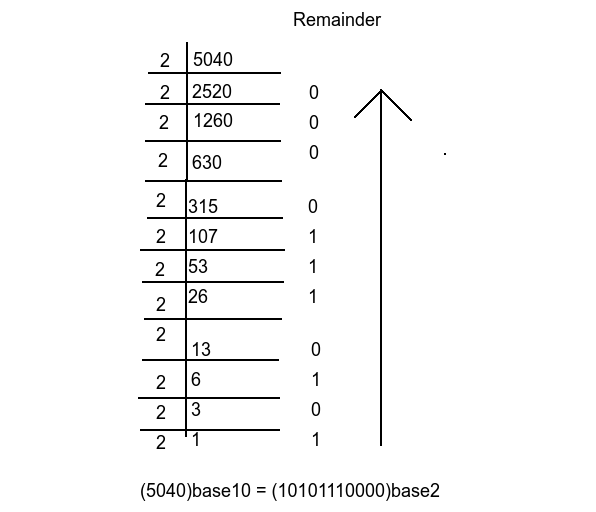
 Data Structure
Data Structure Networking
Networking RDBMS
RDBMS Operating System
Operating System Java
Java MS Excel
MS Excel iOS
iOS HTML
HTML CSS
CSS Android
Android Python
Python C Programming
C Programming C++
C++ C#
C# MongoDB
MongoDB MySQL
MySQL Javascript
Javascript PHP
PHP
- Selected Reading
- UPSC IAS Exams Notes
- Developer's Best Practices
- Questions and Answers
- Effective Resume Writing
- HR Interview Questions
- Computer Glossary
- Who is Who
Find the Number of Trailing Zeroes in base B Representation of N! using C++
In this article, we will understand the problem of finding trailing zeros of a given number N in the base B representation of its factorial. For examples
Input : N = 7 Base = 2 Output : 4 Explanation : fact(7) = 5040 in base10 and 1001110110000 in base16 having 4 trailing zero. Input : N = 11 Base = 5 Output : 2 Explanation : fact(11) = 39916800 in base10 and 40204314200 in base16 having 2 trailing zeroes.
Let's first recap the process of converting any decimal number from one base to another. Let's take an example of converting (5040)10 to (?)2

i.e., dividing the number by 2 and keeping the remainder until the number cannot be further divided. The result will be the remainder in reverse order.
As a result, we have 4 trailing zero, and this trailing zero we got when 2 divides the number with remainder 0.
Prime factorization of 5040 = 24 * 56711 * 3381 * 181 that means 2 divides 5040 4 times with remainder 0 which is equal to trailing zeroes. In this way, we can calculate the number of trailing zeroes.
Approach to find The Solution
We discussed above the way to find the number of trailing zeroes. We need to find the highest power of B in factorial N, let's say base B = 14, then 14 in base 14 will be represented as 10, i.e. (14)10 = (10)14. It is also known as Legendre's formula.
C++ Code for the Above Approach
Here is the C++ syntax which we can use as an input to solve the given problem −
Example
#include <bits/stdc++.h>
using namespace std;
vector < pair < int, int >> primeFactorsofBase(int Base) {
// declaring factors to store prime factors
// along with occurence in factorisation of Base .
vector < pair < int, int >>factors;
for (int i = 2; Base != 1; i++) {
if (Base % i == 0) {
int count = 0;
while (Base % i == 0){
Base = Base / i;
count++;
}
factors.push_back (make_pair (i, count));
}
}
return factors;
}
int main () {
int N = 11, Base = 5;
// finding the largest power of Base that divides factorial N.
vector < pair < int, int >>prime_factors;
// finding prime factors by primeFactorsofBase() function.
prime_factors = primeFactorsofBase(Base);
int result = INT_MAX;
for (int i = 0; i < prime_factors.size (); i++) {
// calculating minimum power.
int count = 0;
int r = prime_factors[i].first;
while (r <= N){
count += (N / r);
r = r * prime_factors[i].first;
}
result = min (result, count / prime_factors[i].second);
}
//printing trailing zeroes stored in result.
cout << "Number of trailing zeroes: " <<result;
return 0;
}
Output
Number of trailing zeroes: 2
Explanation of the above code
- find the largest power of Base using a vector.
- To calculate the largest power, calculate prime factors using vectors to store all prime factors.
- Then calculate the minimum power of all prime factors of Base.
- Finally, printing the result.
Conclusion
In this article, we solve the problem of finding the number of trailing zeroes in the base B representation of factorial N, which we solve using Legendre’s formula. We also write C++ code to solve the same problem. You can write this code in any other language like Java, C, python, etc. We hope you find this article helpful.

